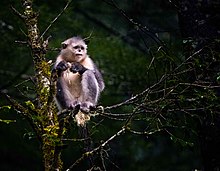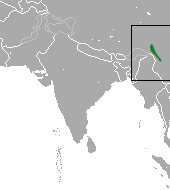| Black-and-white snub-nosed monkey | |
|---|---|

| |
| Scientific classification | |
| Domain: | Eukaryota |
| Kingdom: | Animalia |
| Phylum: | Chordata |
| Class: | Mammalia |
| Order: | Primates |
| Suborder: | Haplorhini |
| Infraorder: | Simiiformes |
| Family: | Cercopithecidae |
| Genus: | Rhinopithecus |
| Species: | R. bieti
|
| Binomial name | |
| Rhinopithecus bieti (A. Milne-Edwards, 1897)
| |

| |
| Black snub-nosed monkey range | |

The black-and-white snub-nosed monkey (Rhinopithecus bieti),[3][4] also known as the Yunnan snub-nosed monkey,[5] is a large black and white primate that lives only in the southern Chinese province of Yunnan,[6] where it is known to the locals as the Yunnan golden hair monkey (Chinese: 滇金丝猴) and the black-and-white snub-nosed monkey (黑白仰鼻猴).[7][8] The common name, black snub-nosed monkey, is issued to Rhinopithecus strykeri, inhabiting the Northern Sino-Myanmar border.[9] Coniferous and deciduous forests in the mountainous regions of Yunnan are the ideal terrain for these primates.[10] It is threatened by habitat loss, and is considered an endangered species. With their unique adaptations to their environment, these monkeys thrive at extreme altitudes despite the below freezing temperatures and thin air.[11] This primate's diet is mainly made up of the large amounts of lichens available in their region.
- ^ Yongcheng, L.; Bleisch, W.V.; Richardson, M. (2020). "Rhinopithecus bieti". IUCN Red List of Threatened Species. 2020: e.T19597A17943738. doi:10.2305/IUCN.UK.2020-2.RLTS.T19597A17943738.en. Retrieved 16 November 2021.
- ^ "Appendices | CITES". cites.org. Retrieved 2022-01-14.
- ^ Zhang, Guiming; Zhu, A-Xing; He, Yu-Chao; Huang, Zhi-Pang; Ren, Guo-Peng; Xiao, Wen (2020). "Integrating multi-source data for wildlife habitat mapping: A case study of the black-and-white snub-nosed monkey (Rhinopithecus bieti) in Yunnan, China". Ecological Indicators. 118: 106735. doi:10.1016/j.ecolind.2020.106735. S2CID 224862888.
- ^ Qianzhao, J. I.; Rongxing, Wang; Zhipang, Huang; Jiahong, Yuan; Guopeng, R. E. N.; Wen, Xiao (2019). "Effects of sample size and study range on accuracy of MaxEnt in predicting species distribution: a case study of the black-and-white snub-nosed monkey". Acta Theriologica Sinica. 39 (2): 126. doi:10.16829/j.slxb.150203. ISSN 1000-1050.
- ^ Afonso, Eve; Fu, Rong; Dupaix, Amaël; Goydadin, Anne-Claude; Yu, ZhongHua; Callou, Cécile; Villette, Petra; Giraudoux, Patrick; Li, Li (2021). "Feeding sites promoting wildlife-related tourism might highly expose the endangered Yunnan snub-nosed monkey (Rhinopithecus bieti) to parasite transmission". Scientific Reports. 11 (1): 15817. Bibcode:2021NatSR..1115817A. doi:10.1038/s41598-021-95166-5. PMC 8339071. PMID 34349189.
- ^ Richardson, Matt (February 13, 2006). "Yunnan snub-nosed monkey videos, photos and facts - Rhinopithecus bieti". Wildscreen Arkive. Archived from the original on 2008-12-05. Retrieved 2018-10-23.
- ^ Groves, C. P. (2005). Wilson, D. E.; Reeder, D. M. (eds.). Mammal Species of the World: A Taxonomic and Geographic Reference (3rd ed.). Baltimore: Johns Hopkins University Press. p. 173. ISBN 0-801-88221-4. OCLC 62265494.
- ^ Harding, Lee E; Han, Lian-Xian (2018-10-05). "Rhinopithecus bieti (Primates: Cercopithecidae)". Mammalian Species. 50 (969): 148–165. doi:10.1093/mspecies/sey016. ISSN 0076-3519.
- ^ Yang, Yin; Groves, Colin; Garber, Paul; Wang, Xinwen; Li, Hen; Long, Yongchen; Li, Guangsong; Tian, Yingping; Dong, Shaohua (2019-03-01). "First insights into the feeding habits of the Critically Endangered black snub-nosed monkey, Rhinopithecus strykeri (Colobinae, Primates)". Primates. 60 (2): 143–153. doi:10.1007/s10329-019-00717-0. ISSN 1610-7365. PMID 30847671. S2CID 71145324.
- ^ Abrams, Sylvie (April 2018). "Yunnan snub nosed monkey". New England Primate Conservancy. Archived from the original on 2016-05-16. Retrieved 2018-10-23.
- ^ "New study reveals adaptations for snub-nosed monkeys". Oxford University Press. August 23, 2016. Retrieved 2018-10-23.
